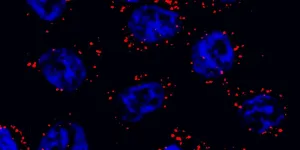(Press-News.org) Researchers at Vanderbilt University Medical Center (VUMC) have identified a common mechanism underlying a spectrum of epilepsy syndromes and neurodevelopmental disorders, including autism, that are caused by variations in a gene encoding a vital transporter protein in the brain.
Their findings, reported last month in the journal Brain, suggest that boosting transporter function via genetic or pharmacological means could be beneficial in treating brain disorders linked to these genetic variations.
"This points (to) a clear direction of treating a wide spectrum of neurodevelopmental disorders, from various epilepsy syndromes (and) autism to neurodevelopmental delay and intellectual disabilities, caused by the pathological variants in this gene," said Jing-Qiong (Katty) Kang, MD, PhD, associate professor of Neurology and Pharmacology, and the paper/s corresponding author.
"The disorders associated with the gene mutations are rare and there is no effective treatment available," Kang said. "If ... the clinical syndromes we see are the tip of an iceberg, we now know what is going on underneath, and we start to know how to correct the problems."
The gene, SLC6A1, encodes the GABA transporter 1 (GAT-1) at the axonal termini (ends) of neurons (nerve cells) and astrocytes (star-shaped glial cells that support and protect neurons). GAT-1 removes or "reuptakes" GABA, the major inhibitory neurotransmitter, from the synaptic cleft between two neurons.
GABA regulates nerve signals throughout the brain and plays a key role in normal brain development. Reuptake enables the brain to precisely regulate the supply of the neurotransmitter in concert with GABAA receptors, ion channels that bind it.
Kang and her colleagues have extensively studied GABAA receptors and are world
leaders in determining how disrupted GABA signaling can affect brain function and development.
SLC641 variants previously have been associated with a spectrum of epilepsy syndromes, autism and impaired cognition. But until now scientists did not know how these variants could cause such a broad range of brain disorders.
Using high-throughput assays such as flow cytometry and a radioactive labeling technique for measuring GABA reuptake by neurons and astrocytes, the VUMC researchers determined the impact of 22 different variants of SLC6A1 on GAT-1 function in several types of nerve cells derived from patients with neurodevelopmental disorders, epilepsy and autism.
The work was validated in patient-induced pluripotent stem cells that were "reprogrammed" to form neurons and astrocytes.
The researchers found that disease-causing variants were associated with misfoldings of the GAT-1 protein that led to its degradation and which reduced its expression on cell surfaces. Less GAT-1, in turn, lowered GABA reuptake by nerve cells and astrocytes and disrupted neurotransmitter function.
"This is the first large-scale study on SLC6A1 pathological variants," Kang said. "Our work indicates that SLC6A1-mediated disorders are good candidates for pharmacological as well as gene therapy that restore the functional transporter at the cell surface."
A compound identified at VUMC that corrects GAT-1 function in mouse models and cells from patients with urea cycle disorder is now being tested in a clinical trial. The inherited disease causes a buildup of ammonia in the bloodstream that can damage the brain and may be fatal.
Another potential approach is the use of antisense oligonucleotides, short, synthetic pieces of genetic material that may increase expression of the normal, "wild-type" GAT-1 protein.
Kang said the research could not have been done without the help of two "hero" mothers of children with rare genetic disorders: Amber Freed, founder and CEO of the Denver-based advocacy group SLC6A1 Connect; and Terry Jo Bichell, PhD, founder and director of Nashville-based COMBINEDBrain, which supports brain research.
"I have been very lucky and privileged to work with them," Kang said. "They have taught me so much along the way and inspired me to do meaningful research."
"She loves kids with SLC6A1 as her own and selflessly works to improve their lives with the urgency of a mother," Freed responded. "Throughout this journey, Katty has been a loving person, inquisitive scientist and pillar of strength."
"That empathy kept her discoveries progressing through the pandemic," Bichell added. "She would ride her bicycle to the lab and care for the mouse and cell models at night, on weekends and even holidays ... Dr. Kang is doing basic science that will translate to real treatments for real children she has met--and hugged."
Felicia Mermer and Sarah Poliquin are the paper's first authors. Other VUMC co-authors are Kathryn Rigsby, Anuj Rastogi, Wangzhen Shen, MD, Alejandra Romero-Morales, Gerald Nwosu and Vivian Gama, PhD.
INFORMATION:
The research was supported by SLC6A1 Connect, Taysha Gene Therapies, the Charles C. Gates Center Director's Innovation Fund, the Stoddard family, and by National Institutes of Health grants NS082635, GM128915, CA227483 and MH116901.
June 9, 2021 - The first analysis of medical evidence on domestic mass shooters in the U.S. finds that a large majority of perpetrators have psychiatric disorders for which they have received no medication or other treatment, reports a study in the Journal of Clinical Psychopharmacology. The journal is published in the Lippincott portfolio by Wolters Kluwer.
"Without losing sight of the larger perspective that most who are violent are not mentally ill, and most of the mentally ill are not violent, our message is that mental health providers, lawyers, and the public should be made aware that some unmedicated patients do pose an increased risk of violence," according to the report by Ira D. Glick, MD, of Stanford University School of Medicine and colleagues.
In-depth analysis of ...
Smithsonian Conservation Biology Institute scientists are one step closer to understanding why some corals can weather climate change better than others, and the secret could be in a specific protein that produces a natural sunscreen. As their name implies, Hawaiian blue rice corals sport a deep blue pigment, which is created by chromoprotein and filters out harmful ultraviolet (UV) radiation from the sun. Although UV damage may produce long-term impacts to reproduction in many coral species--including brown rice coral--it may not have the same effect on blue rice coral. The findings of this study were published June 9 in ...
From 1980 to 2016, grain production in Brazil increased more than fourfold, and the country now stands as the world's largest soybean exporter and the second largest exporter of corn. The two main drivers of this increase in food production were cropland expansion and double-cropping, harvesting two crops, such as corn and soybeans, from the same field in a single year.
While cropland expansion has long been recognized as one of the drivers behind the increase in Brazil's agricultural output, a new study published in Nature Food quantifies for the first time the impact that double-cropping also ...
The fairy circles of the Namib are one of nature's greatest mysteries. Millions of these circular barren patches extend over vast areas along the margins of the desert in Namibia. In 1979, G.K. Theron published the first research about their origin. His hypothesis was that poisonous substances from Euphorbia damarana leaves induced fairy circles. As part of a new study, scientists from the University of Göttingen and the Gobabeb Namib Research Institute located the original euphorbia plants that were part of Theron's study. Four decades later, the researchers are now able to conclusively disprove Theron's original hypothesis. Their results were published in the journal BMC Ecology and Evolution.
In the late 1970s, South African botanist Theron noticed ...
A University of Oklahoma doctoral student, graduate and undergraduate research assistants, and an associate professor in the Homer L. Dodge Department of Physics and Astronomy in the University of Oklahoma College of Arts and Sciences are lead authors on a paper describing a "changing-look" blazar - a powerful active galactic nucleus powered by supermassive blackhole at the center of a galaxy. The paper is published in The Astrophysical Journal.
Hora D. Mishra, a Ph.D. student, and faculty member Xinyu Dai are lead authors of the paper, along with Christopher Kochanek and Kris Stanek at the Ohio State University and Ben Shappee at the University of Hawaii. The paper represents the findings of researchers from 12 different institutions who participated ...
Tsukuba, Japan - Holographic displays help add a three-dimensional--and thus more life-like--feel to what would otherwise appear as a two-dimensional image. Now, researchers in Japan have tested how this may work on a supramolecular level; such tests could lead to improved displays.
Commonly, one cannot overlay a certain type of molecular component that underlies helically arranged liquid crystals onto their molecular mirror images, much like a person cannot overlay their two hands and have them match up exactly without flipping one over. Molecules with this property are described as "chiral." Some materials make use of the principle of chirality to rotate light in a plane perpendicular to the direction of the light wave, known as circular ...
Researchers from the Singapore University of Technology and Design (SUTD) have developed novel techniques, known as Automated Fibre Embedding (AFE), to produce complex fibre and silicone composite structures for soft robotics applications. Their work was published in IEEE Robotics and Automation Letters.
Many soft robot components, including sensors and actuators, utilise embedded continuous fibres within elastomeric substrates to achieve various functionalities. However, manual embedding of continuous fibres in soft substrates is challenging due to the complexities involved in handling precise layering, and ...
Thermotherapy or heat treatment can help in treating lesions and other tissue injuries. For example, chemotherapy or radiotherapy, when combined with thermotherapy, kills tumorous cells more effectively. Thermotherapy is considered a promising approach for treating internal lesions, but the advancement in the field depends on the availability of patient-friendly heat-inducing devices capable of rapidly increasing the temperature of target tissues.
Current clinical practices around thermotherapy majorly employ heat-generating devices that are probed inside ...
DALLAS - June 9, 2021 - A phenomenon in which an RNA named NORAD drives a protein named Pumilio to form liquid droplets in cells, much like oil in water, appears to tightly regulate the activity of Pumilio. A new study led by UT Southwestern scientists suggests that such RNA-driven "phase separation," in turn, protects against genome instability, premature aging, and neurodegenerative diseases, and may represent a previously unrecognized way for RNAs to regulate cellular processes.
"It's becoming more and more clear that phase separation is an important organizing ...
A research team, led by Professor Kyoung-Duck Park in the Department of Physics at UNIST has succeeded in investigating and controlling the physical properties of naturally-formed nanoscale wrinkles in two-dimensional (2D) semiconductors. This is thanks to their previously-developed hyperspectral adaptive tip-enhanced photoluminescence (a-TEPL) spectroscopy. This will be a major step forward in developing paper-thin, ultra-flexible displays.
Wrinkles are an inevitable structural deformation in 2D semiconductor materials, which gives rise to spatial heterogeneity in material properties, according to the research team. Such structural deformation has long been considered one of the top technical challenges in semiconductor manufacturing, as this would harm the uniformity ...








